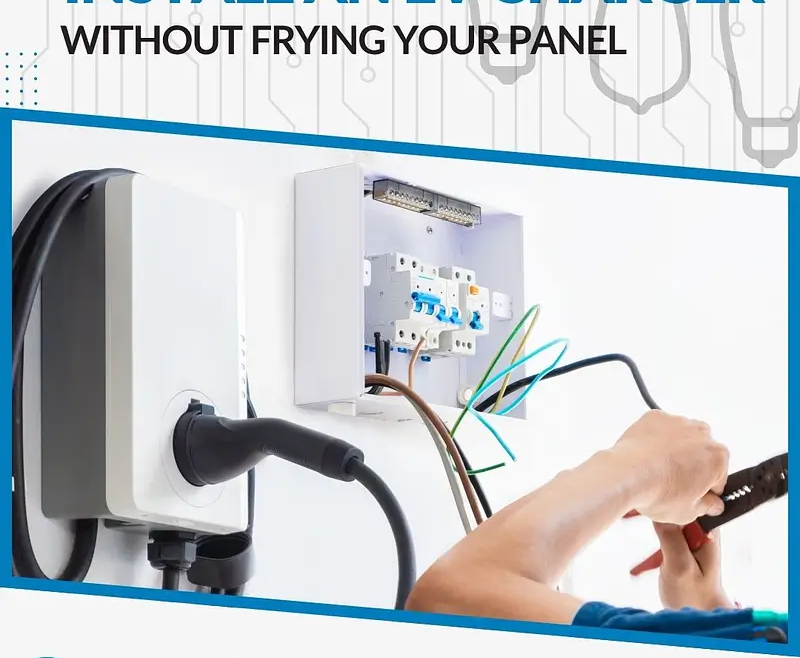You must be thinking about switching to an electric vehicle, or maybe you already have, and now you’re staring at your garage wall, wondering, “Where do I even begin?” Charging an EV at home is one of the biggest perks of owning one, but how to install an EV charger at home isn’t exactly common knowledge. The good news? It’s more doable than you might think, especially with the right team on your side.
You’d want to know what’s involved before you start unscrewing panel covers or searching for YouTube tutorials. Installing an EV charger at home means understanding your home’s electrical system, choosing the right charger type, and making sure everything is code-compliant and future-ready. It’s not just about convenience; it’s about doing it safely and efficiently.
A question might pop into your mind: can I install it myself, or should I call in a pro? In most cases, it’s best to leave it to the professionals, especially when your home’s power load, panel capacity, and long-term safety are on the line. As electrical service providers for homeowners in Winnipeg, we believe it’s our duty to walk you through exactly what you need to know. If you’re about to unscrew your electrical system, wait; give us five minutes to go over the basics.
Step 1- Know Your Power – Evaluate Your Electrical Panel
You must be wondering if your home’s current electrical panel can even support an EV charger. That’s the first thing we check when customers ask us how to install an EV charger at home. Most Level 2 chargers (which are far more efficient than Level 1 trickle chargers) require a dedicated 240V circuit, something not all older homes are equipped for.
Our team at Edison Electric Services starts with a full panel assessment to see if you have the amperage and space needed. If your panel is outdated or maxed out, we’ll help you plan an upgrade so your charger runs safely without overloading your system.
Step 2- Pick the Right Charger (Because One Size Doesn’t Fit All)
You’d want to know that EV chargers come in different types. Level 1 chargers plug into a standard 120V outlet but take forever to charge a car; fine for emergencies but not ideal for daily use. Most homeowners go for a Level 2 charger, which uses a 240V connection and can fully charge a car in 6–10 hours.
We guide homeowners in selecting the right model based on their vehicle, usage habits, and budget. Some units are “smart” and can be scheduled via smartphone; others are simpler but equally reliable. Either way, the key to success lies in proper EV charger installation, and that’s where we come in.
Step 3: Permits, Placement, and Professional Wiring
You must be thinking, “Is this even legal to DIY?” In Manitoba, all permanent EV charger installations require a permit and must comply with the Canadian Electrical Code. Improper wiring or placement can not only void warranties but can also pose a fire hazard.
As licensed electricians in Winnipeg, Edison Electric Services handles all the paperwork, ensures code compliance, and wires the unit with precision. We help you choose an optimal location, usually the garage wall or driveway-adjacent exterior, and install outdoor-rated enclosures if needed. This ensures your system is safe, accessible, and built to last through Manitoba winters.
Step 4: Inspection and Power-Up
You’d want peace of mind knowing everything was done right, and that’s why we schedule a final inspection with Manitoba Hydro or your local permitting authority. Once approved, we will test your new EV charger, walk you through how it works, and answer any questions you have.
With Edison Electric Services, the process doesn’t just stop at installation. We’re here for future maintenance, troubleshooting, or additional upgrades like integrating your EV charger with solar power or backup generators.
Why You Shouldn’t DIY Your EV Charger Installation
A question might come up: What’s the risk if I try this myself? The answer may “shock” you, literally. When electricity is involved, you have to take extreme precautions to ensure your safety. The home electrical system carries about 120V, which, if exposed, can be lethal. Always make sure you’re handling the electrical system with the proper precautions. Other than that, damaged equipment, insurance voids, and potential fires are all reasons why you shouldn’t DIY EV charger installation if you don’t know what you’re doing. Not to mention possible violations of local regulations. When it comes to how to install an EV charger at home, it’s not about skill with tools; it’s about knowing Manitoba’s electrical codes and safety standards.
Our electricians at Edison Electric Services have years of experience installing residential EV chargers across Winnipeg. We ensure every wire, breaker, and outlet is professionally installed, labelled, and ready for daily use.
Charge Up the Right Way, Safely and Confidently
You’re likely realized that how to install an EV charger at home is less about plugging in a device and more about planning a long-term, safe solution. From evaluating your panel to ensuring code compliance and clean installation, it’s a job best left to experienced professionals.
Edison Electric Services makes the process seamless for homeowners in Winnipeg. We handle everything, from permits to panel upgrades, so you can charge with confidence. Ready to electrify your driveway? Let’s get your charger installed the right way the first time.




